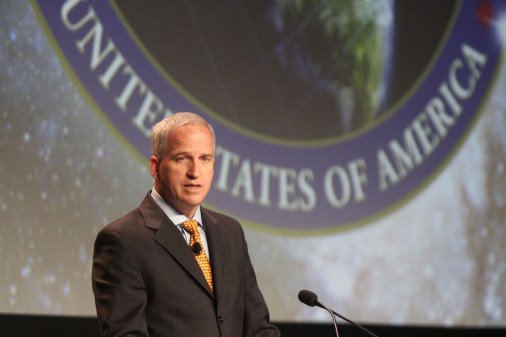Inside a CRADA: NGA explores emerging geospatial tech in cooperative deal with Planet

Government technology typically revolves around money changing hands.
But some government deals don’t come with cash.
The National Geospatial-Intelligence Agency announced last month it had entered into such a deal — a Cooperative Research and Development Agreement (called a CRADA) — with commercial imagery provider Planet. The CRADA allows the company the chance to give NGA early access and insights into the analytics it’s developing for geospatial imagery, said Jennifer Marcus, vice president of federal operations at Planet.
NGA has contracted with Planet before and has an ongoing contract with the company for its global imagery feed. But through the CRADA, NGA is getting a deeper look at the automated analysis Planet could offer on that data, according to Mike Applegate, Planet subscription program manager for NGA.
But why would a company be interested in a deal where cash isn’t part of the equation or isn’t even promised for a later date? It’s all about getting an inside look at the agency’s specific challenges, said Manuela McCabe, NGA’s program manager assigned to the Planet CRADA.
“We don’t come to the table with data, we don’t come to the table with software,” she said in an interview with FedScoop. “We basically come to the table with giving them an insight into how we operate. And really where we have gaps that need to be potentially filled by industry.”
One of those potential gaps: NGA’s analysts are spending a lot of time going manually through imagery in a way that could possibly be automated, the program managers said.
“Planet is collecting petabytes of data daily in terms of imagery. And our analysts don’t have the time or the ability to look at all of that imagery,” McCabe said. “So we want to be able to extract information from hundreds of scenes of imagery that will potentially tell us where something has changed on the landscape.”
To go alongside the host of imagery Planet offers, its engineers are now developing “automated detection of change in buildings, change in roads, [and] movement of certain types of vehicles” to help analysts more effectively sift through massive amounts of data, Marcus said.
“It basically alerts them something is going on in this area,” she told FedScoop. “They still then have to go in and check it out with their eyes, but it’s eliminating them having to fish through all of that imagery themselves.”
Though all CRADAs are different, McCabe said a big focus for this one is bringing the agency’s analysts closer to industry “so that they can actually engage and understand how some of these automated services can be developed.”
To do that the agency and Planet scheduled “engagement sessions” where Planet’s staff and the agency’s analysts can work one-on-one. The first was in April, and the next is scheduled for early this month, McCabe said. Planet staff can even bring their laptops into NGA’s space, and since none of the Planet staff is cleared, all of the information is unclassified, McCabe said.
“We work with our analysts to kind of scrub down their issues to the unclassified level,” she said. “Sometimes when they’re describing their problem we have to be somewhat vague.” The company’s staff and NGA’s analysts sit together all day brainstorming, McCabe said.
One thing Planet’s staff learned from NGA’s analysts was what level of accuracy would be useful to them, Marcus said.
“They were pleasantly surprised that any indicators of where to look is better than nothing,” she said. “So I think they were validated in the approach to have — you can set parameters on these analytics to say, ‘Let me know if anything changes at all, or let me know if some way more specific change happens.’ They were very happy to hear that both ends of the spectrum would be useful.”
The CRADA with Planet is one of many NGA has with industry and academia, McCabe said. Since NGA’s somewhat-new Office of Ventures and Innovation was stood up, the team has been focusing on establishing CRADAs, Chief Ventures Officer Christy Monaco told FedScoop in April.
“I kind of joke around that we’ve been doing public-private partnership one CRADA at a time,” she said.
Marcus, though, said this CRADA is a first for the company.
“We’re doing similar things, maybe not under CRADA but with customers that we have in the agriculture space and in other commercial markets,” Marcus said. “It helps us to understand how far we take the commercialization, and then where we need to work with a partner or somebody who kind of does the industry-specific customization.”
On the NGA side, CRADAs are useful when the agency is interested in a “still developing capability” but maybe doesn’t understand to what extent the product or service could be applied to the mission, said Gregory Black, senior GEOINT authority for commercial imagery and services.
“Basically it looks like it’s going to be really interesting but you need to learn more about it,” Black told FedScoop.
Through the CRADA, Planet and NGA are both able to figure out if they need to tweak anything to make use of the new analytics, Marcus said. For example, NGA might tweak its systems to receive the analytics, or Planet might need to adjust the way the analytics are being delivered to make it easier for NGA’s analysts, she said.
When it comes to the agency’s strategy around interacting with industry, Black said he thinks the agency will continue to use CRADAs in the future.
“If I just think about the fact that the commercial GEOINT marketplace is a pretty dynamic market, I feel like CRADAs are still definitely going to be valuable,” he said.




